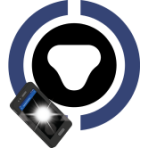 Links for Flash Access
Links for Flash Access
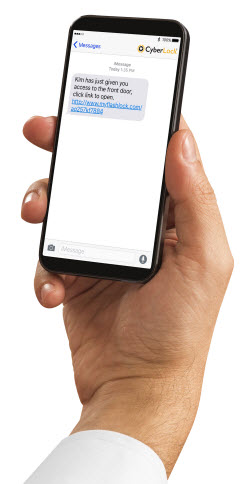
|
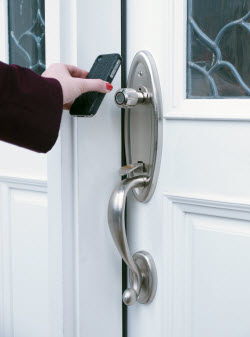
|
Permission for Flash Access is granted by sending a text message or an email to a selected person in CyberAudit-Web's list of people. Both messages contain two links. One is used with the devices browser. The other may be used with the Flash Access app.
Steps to Send Flash Access Links|
Ensure the person has an entry for either an email address or a mobile number. Select Properties from the click menu for the selected person. |
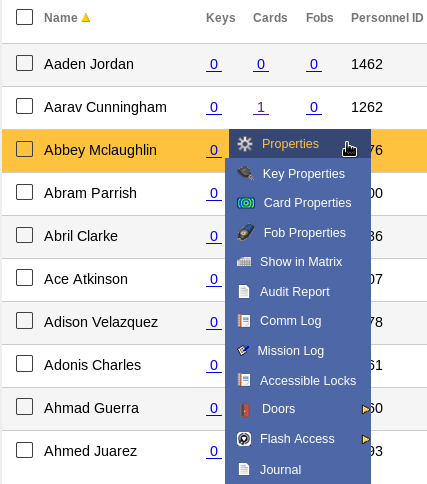
|

|
|
| Ensure there is an entry for either an email address or a mobile phone in the appropriate field. Click Save. | |
| To send the Flash Access Link, select Send Flash Access from the click menu. |
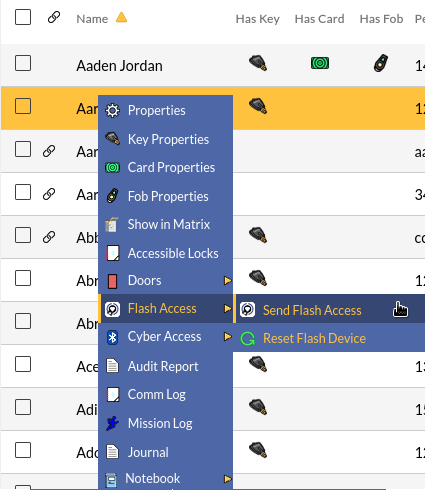
|
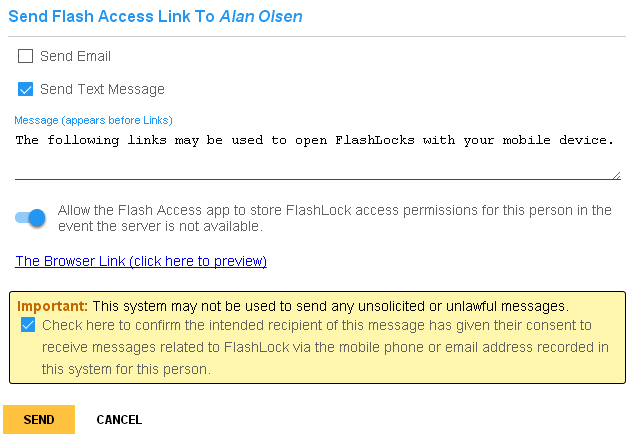
|
|
|
If the account has a text message service
a Send Text Message checkbox will appear. It will be enabled if there is an entry in the
mobile number field of people properties.
Likewise, the option to send an email will be enabled if the email field has an entry.
Check one or both of these options then click Send to send the Flash Access link.
Clicking The Link in the same page executes the link to be sent.
It may be used for testing. Click Send to send the link to the selected method. This link may be used by the recipient to gain Flash Access to FlashLocks to which they have been granted access. |
|
Using a Flash Access Link
| Links for Flash Access are unique for each person in the system. The content of each link identifies the person requesting access. This section describes what the user sees when they open the browser link they receive either by email or text message. |
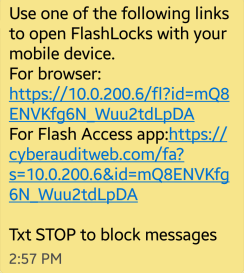
|
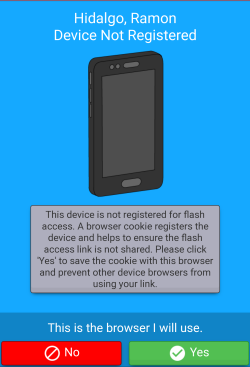
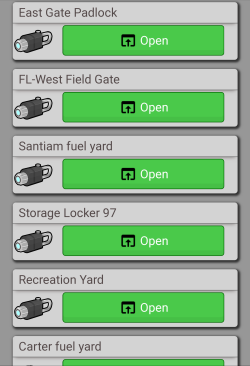
|
|
|
CyberAudit-Web attempts to associate a person with a single browser or instance of running on a single device.
It does this by generating a cookie or token to be stored in the cache of the browser or the
Flash Access app on the local device.
This token is then sent to the server with each subsequent access request. This helps deter other
devices from using that link to gain access to the list of FlashLocks for a person. If
CyberAudit-Web has not yet recorded a token for that browser, a page appears encouraging the user
to click Yes to save the token. If just testing the link, click No.
The token may be made mandatory by checking the Require Device Token checkbox in Global
Preferences, FlashLock Preferences. If testing
a link where a token is required, the cookie must be accepted to test. When testing is complete,
reset the device token to allow the user
to register their own device.
If the selected person has been granted access to one or more FlashLocks, the list of locks will be shown in the browser window. Click Open on a selected lock to request Flash Access. |
|
| A Warning message appears regarding the rapidly flashing lights that are used to open the lock. |
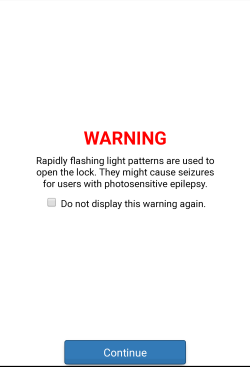
|
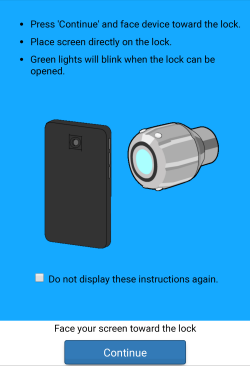
|
An instruction page tells how to procede and demonstrates how to position the mobile device to open the FlashLock. |
| A countdown page gives the user 3 seconds before the flashing begins. When the flashing begins the device should be against the light window of the FlashLock. The FlashLock will normally respond to open within six seconds. As indicated in the instruction page, green LEDs on the FlashLock will blink to indicate access was granted. |
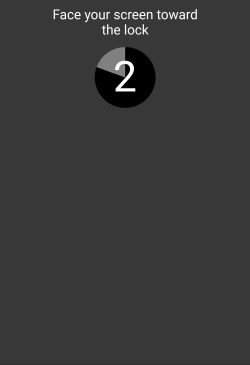
|
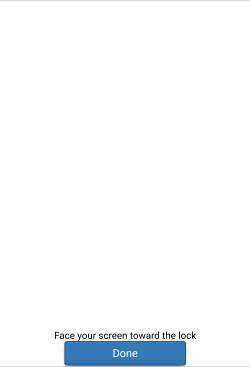
|
The FlashLock will normally respond to open within six seconds. As indicated in the instruction page, green LEDs on the FlashLock will blink to indicate access was granted. Click Done to stop the flashing. |
| The next screen asks the user if they were successful opening the lock. Clicking Yes sends a message to the FlashLock server to record an event. |
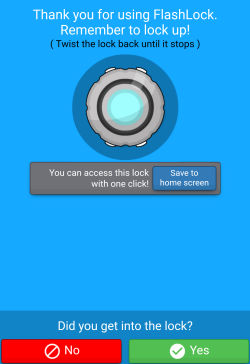
|
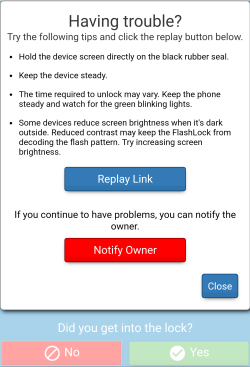
|
If the user clicks No at the previous screen, a troubleshooting screen appears. They may try Flash Access again by clicking Replay Link. Clicking Notify Owner sends a message to the FlashLock server to record an event. A notification may be created to send an email or text message triggered by that event. |
| All screens time out within 10 minutes. Clicking Replay Link in the screen above restarts that timer. |

|
A Reminder to Re-Lock the FlashLock
A reminder may be enabled for each FlashLock to re-lock it after it has been opened. It will be sent sent to the person who opened the lock a determined amount of time after they request Flash Access. The reminder is enabled in FlashLock properties.

The reminder will be sent to anyone who requests Flash Access for the lock. If text messaging is enabled for the system and the person has a mobile number the reminder will be sent by text message. If not, it will fall back to sending the reminder by email.
If the person reports they have failed to open the lock, the reminder will be cancelled.
Clearing the User's Browser Cookie
In the event a user wishes the change browsers or devices, the user's browser cookie may be cleared from CyberAudit-Web as follows.
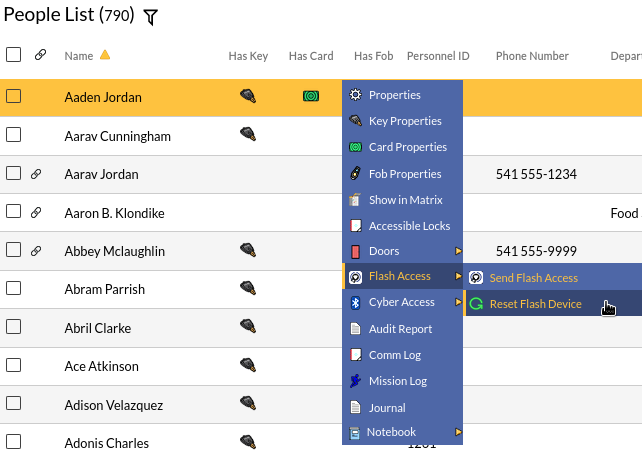
|
Find the user's name in the People page. Click on their record and select Reset Flash Device from the click menu. On success, the user may now use their link with a different device for Flash Access. |

